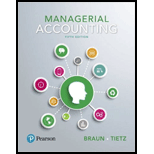
a.
To identify: The type of activity using following abbreviations in the given statement:
1. Operating activity—addition to net income (O+)
2. Operating activity—subtraction from net income (O–)
3. Financing activity (F)
4. Investing activity (I)
5. Activity that is not on the statement of
b.
To identify: The type of activity using following abbreviations in the given statement:
1. Operating activity—addition to net income (O+)
2. Operating activity—subtraction from net income (O–)
3. Financing activity (F)
4. Investing activity (I)
5. Activity that is not on the statement of cash flows (NA)
c.
To identify: The type of activity using following abbreviations in the given statement:
1. Operating activity—addition to net income (O+)
2. Operating activity—subtraction from net income (O–)
3. Financing activity (F)
4. Investing activity (I)
5. Activity that is not on the statement of cash flows (NA)
d.
To identify: The type of activity using following abbreviations in the given statement:
1. Operating activity—addition to net income (O+)
2. Operating activity—subtraction from net income (O–)
3. Financing activity (F)
4. Investing activity (I)
5. Activity that is not on the statement of cash flows (NA)
e.
To identify: The type of activity using following abbreviations in the given statement:
1. Operating activity—addition to net income (O+)
2. Operating activity—subtraction from net income (O–)
3. Financing activity (F)
4. Investing activity (I)
5. Activity that is not on the statement of cash flows (NA)
f.
To identify: The type of activity using following abbreviations in the given statement:
1. Operating activity—addition to net income (O+)
2. Operating activity—subtraction from net income (O–)
3. Financing activity (F)
4. Investing activity (I)
5. Activity that is not on the statement of cash flows (NA)
g.
To identify: The type of activity using following abbreviations in the given statement:
1. Operating activity—addition to net income (O+)
2. Operating activity—subtraction from net income (O–)
3. Financing activity (F)
4. Investing activity (I)
5. Activity that is not on the statement of cash flows (NA)
h.
To identify: The type of activity using following abbreviations in the given statement:
1. Operating activity—addition to net income (O+)
2. Operating activity—subtraction from net income (O–)
3. Financing activity (F)
4. Investing activity (I)
5. Activity that is not on the statement of cash flows (NA)
i.
To identify: The type of activity using following abbreviations in the given statement:
1. Operating activity—addition to net income (O+)
2. Operating activity—subtraction from net income (O–)
3. Financing activity (F)
4. Investing activity (I)
5. Activity that is not on the statement of cash flows (NA)
j.
To identify: The type of activity using following abbreviations in the given statement:
1. Operating activity—addition to net income (O+)
2. Operating activity—subtraction from net income (O–)
3. Financing activity (F)
4. Investing activity (I)
5. Activity that is not on the statement of cash flows (NA)
k.
To identify: The type of activity using following abbreviations in the given statement:
1. Operating activity—addition to net income (O+)
2. Operating activity—subtraction from net income (O–)
3. Financing activity (F)
4. Investing activity (I)
5. Activity that is not on the statement of cash flows (NA)
l.
To identify: The type of activity using following abbreviations in the given statement:
1. Operating activity—addition to net income (O+)
2. Operating activity—subtraction from net income (O–)
3. Financing activity (F)
4. Investing activity (I)
5. Activity that is not on the statement of cash flows (NA)
m.
To identify: The type of activity using following abbreviations in the given statement:
1. Operating activity—addition to net income (O+)
2. Operating activity—subtraction from net income (O–)
3. Financing activity (F)
4. Investing activity (I)
5. Activity that is not on the statement of cash flows (NA)
n.
To identify: The type of activity using following abbreviations in the given statement:
1. Operating activity—addition to net income (O+)
2. Operating activity—subtraction from net income (O–)
3. Financing activity (F)
4. Investing activity (I)
5. Activity that is not on the statement of cash flows (NA)
Want to see the full answer?
Check out a sample textbook solution
Chapter 13 Solutions
Managerial Accounting, Student Value Edition Plus MyLab Accounting with Pearson eText -- Access Card Package (5th Edition)
- It was reporting a net profit margin on its salesarrow_forwardPlease give me correct answer this financial accountingarrow_forwardWestpoint Supplies has net working capital of $4,800, total assets of $29,400, and net fixed assets of $18,500. What is the value of the current liabilities?arrow_forward
 Financial Accounting: The Impact on Decision Make...AccountingISBN:9781305654174Author:Gary A. Porter, Curtis L. NortonPublisher:Cengage LearningPrinciples of Accounting Volume 1AccountingISBN:9781947172685Author:OpenStaxPublisher:OpenStax College
Financial Accounting: The Impact on Decision Make...AccountingISBN:9781305654174Author:Gary A. Porter, Curtis L. NortonPublisher:Cengage LearningPrinciples of Accounting Volume 1AccountingISBN:9781947172685Author:OpenStaxPublisher:OpenStax College- Century 21 Accounting Multicolumn JournalAccountingISBN:9781337679503Author:GilbertsonPublisher:Cengage
 Cornerstones of Financial AccountingAccountingISBN:9781337690881Author:Jay Rich, Jeff JonesPublisher:Cengage Learning
Cornerstones of Financial AccountingAccountingISBN:9781337690881Author:Jay Rich, Jeff JonesPublisher:Cengage Learning





